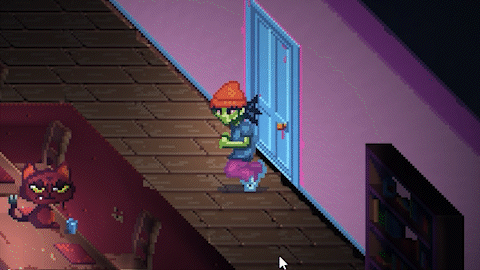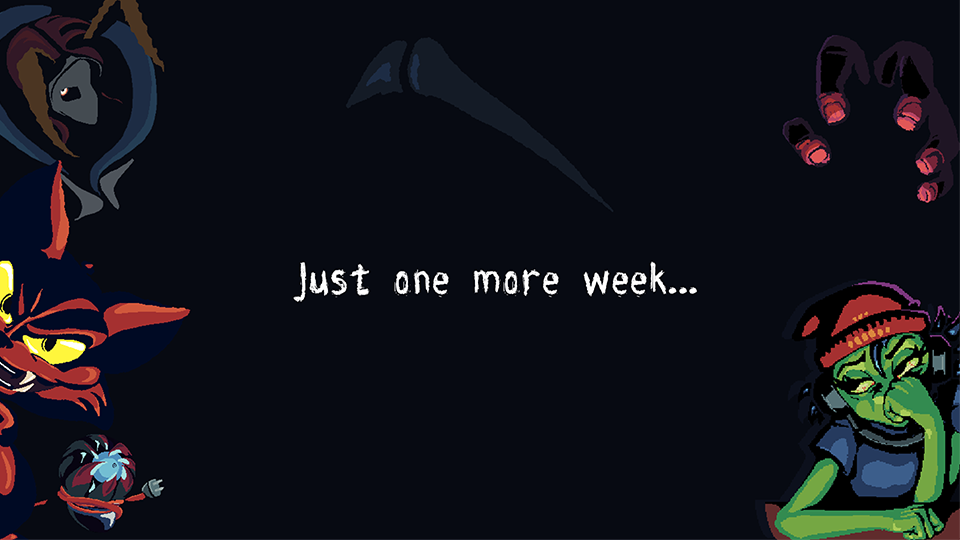A quick chat about some of the invisible work that happens to make a game...

It seems like a million years ago now that the members of Tearcell Game Studio sat together in a Discord call and discussed moving forward with transforming Somnipathy from a limited-mode entry to Ludum Dare 50 into a full narrative experience for retail release. We quickly identified a list of what needed to be done to make that happen, and with public release of our demo on Steam coming up next week we wanted to take a moment to go behind the scenes for some of the business and technical efforts that went into bringing us to this point.
I am Vibe, and along with being the voice behind our weekly blog posts (and a host of other duties related to the development of Somnipathy) I am also the business director for Tearcell Games. I sat down with Darius, our technical director and leader by acclimation and inspiration, and we talked about all the "I's" dotted and "T's" crossed to get where we are today.

Vibe: Let's go back to early May after we decided to make a go of it. I wandered off to do the "guy in a suit" thing and plan out our formation, draft our bylaws, and attempt to project some kind of budget, and you immediately got working on... well, doing what exactly? I know there were a bunch of technical adjustments that needed to be made to turn our jam project into the start of a full Somnipathy game, but can you explain them to me [as if I were a small child, please]?
Darius: With the clear feedback we got from Ludum Dare 50, we knew we were on a great track atmospherically but the gameplay didn't match the strength of our setting. Before rewriting we had to get organized. There are eight of us touching code and assets that started out held together with a combination of duct tape, glue, and prayers. The whole project could turn into an unmaintainable mess of spaghetti code if we didn't invest in good structure before doing anything else. We also had to fix a lot of things that had been hard coded just to make the jam deadline and were not flexible enough to be used as a general API and system to build a larger game around.
Vibe: I saw drafting our bylaws similarly! They are the API for our operations, if you will - the functions and flow chart to how the work gets broken up as well as what needs to be done for us to be a functional company. Continuing to speak of APIs, there was that moment where we had done all of the suit-steps needed to set up as Steam developer-publishers, they had verified that we were "a real boy" - well, a real business - and we had full access to that side of things... which we can't talk about in huge detail, but there was that first moment where it was like, "wow, this is real now," and then you immediately dived into learning how publishing on Steam would work and what was required from a technical perspective...
Darius: I've deployed a lot of software and a lot of systems on a lot of different platforms in my career, and Steam solidly falls in the middle of the spectrum for complexity. They provide a wealth of documentation, tools, and information, but there are definitely best practices that need to be strongly adhered to. They have some deployment concepts that are still a bit confusing even with all my experience, but having command-line APIs to do automations while working on projects has been fantastic. That said, once you get the hang of the "Steam Way" you're unlikely to make mistakes, their high level of organization provides great guardrails for your process. Thankfully for us we had the support of Gramps of CoaguCo Industries, his amazing GodotSteam integration builds, and his strong and supportive community. If I had a question they were there and eager to help.
Vibe: I know from watching this process how much work it was, even if I still don't quite have a grasp on it. If you had to put a number on it, how much time did you spend working on just lining things up so that they'd work later, over that first month after the big thumbs up moment?
Darius: From the original thumbs up moment, it was roughly two solid weeks - about eighty hours total - just pulling off the duct tape and reinforcing the fundamentals (interactables, events, and dialogues) that were the initial pillars of development for us moving forward... and then another six weeks or so before the code was back to a foundation that I was comfortable with us building upon. Then I set our lead writer loose to do in-engine level design, but even today I'm continuing to build new features onto the core of the game's base.
Vibe: And now we're sitting here, and the demo for Somnipathy will go LIVE a WEEK FROM TOMORROW. For me, that's a real surreal feeling. I keep expecting to wake up and I'm 13 again and Steam wasn't even a thing yet and I'm playing X-COM Terror From the Deep for the umpteenth time and thinking, "hey, someday I'd like to make a video game," would you say that you have any kind of similar sensation at times?
Darius: I was sitting here today designing new features for the boss battle at the end of the demo and I couldn't help but stare at my work and think, "this is really cool!" and thinking about how it compares to Mr X in Resident Evil 2. (Ed. Note: We're not saying the first boss is at all the same as Mr X! Just capturing the feeling.) I have those moments most days - when I'm not hunting down bugs that is!
That's it for us for this week. We'll be back next week, talking to some of the creative minds on the team who will be giving us their perspective on what you'll find in the demo. We can't wait for you to play it!

Get Somnipathy
Somnipathy
Full demo now available for download!
| Status | In development |
| Authors | tearcellgames, whiskeybadger, Minkies, MTBVibe, James Thomasos, PickyBurrito49, pnutbutterprincess |
| Genre | Adventure |
| Tags | 2D, Atmospheric, Horror, Ludum Dare 50, Narrative, Pixel Art, Point & Click, Psychological Horror, Singleplayer, Sprites |
| Languages | English |
| Accessibility | One button |
More posts
- 'Somnipathy: Before you wake' releases this FridayFeb 12, 2024
- Somnipathy Web demo and 1.0.4.0 update!Oct 26, 2023
- Somnipathy arrives on September 12th!Aug 05, 2023
- Somnipathy: A new design workflowMay 04, 2023
- Demo 0.4.0 release!Jan 21, 2023
- The itch.io demo is up!Oct 25, 2022
- Screamfest EveOct 24, 2022
- Getting ready for Steam's Indie Next Fest... and GIVEAWAYS?Sep 30, 2022
- Some words of wisdom from our artists and lead writer...Sep 21, 2022
Leave a comment
Log in with itch.io to leave a comment.